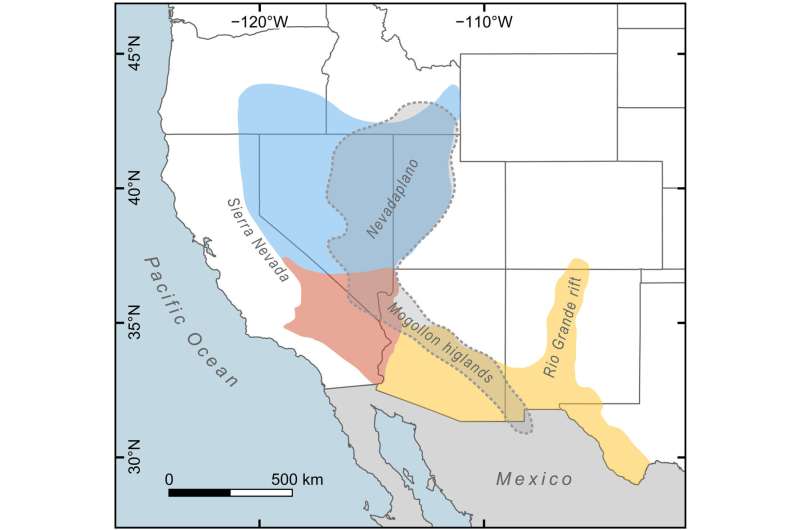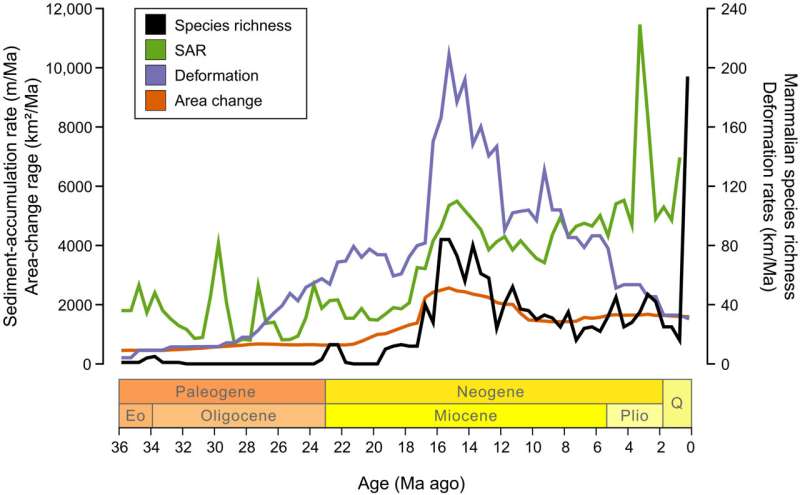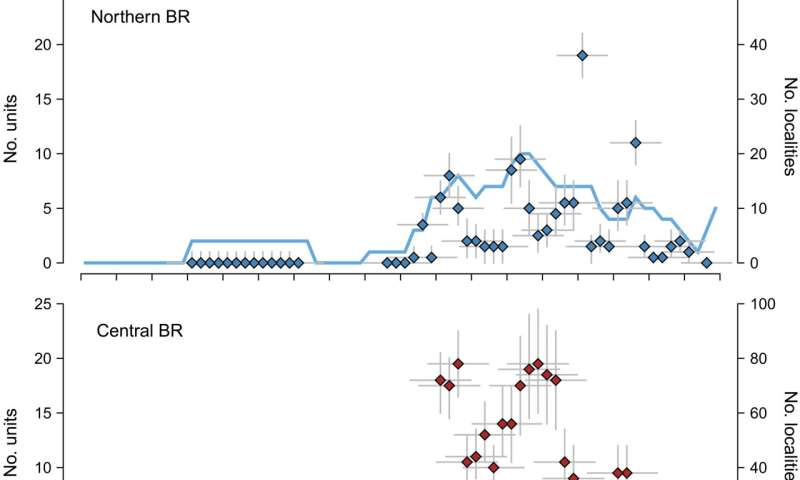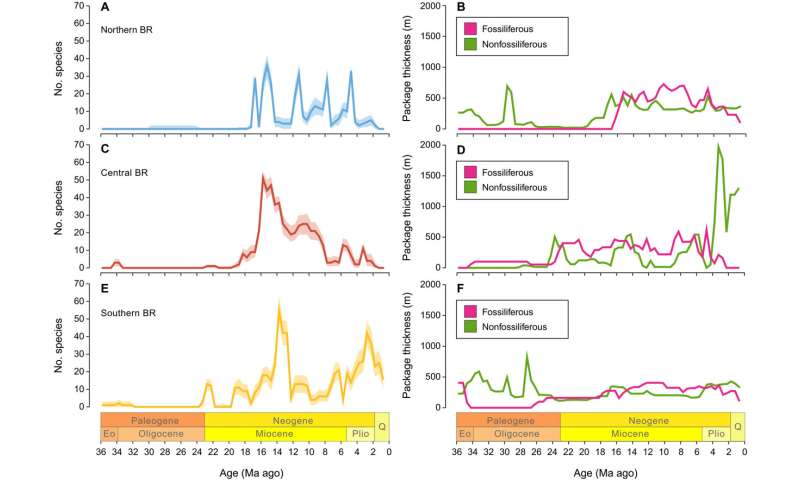Tectonic influence on Cenozoic mammal richness

Speciation and sedimentation are driven by tectonic activity, which causes fossil and rock records to share common patterns through time. During the Miocene, the Basin and Range (BR) of western North America arose through widespread extension and collapse of topographic highlands to create basins rich with mammalian fossil records. In a new report now published on Science Advances, Katharine M. Loughney and a team of scientists in geology, ecology and evolutionary biology, and geosciences in the U.S. analyzed patterns of mammalian species richness from 36 to zero million years ago, relative to the history of sediment accumulation. Using the data, they tested whether intervals of high species richness corresponded with elevated sedimentation, accumulation, and fossil burial during tectonic deformation. The sedimentary record of the region broadly determined the preservation of the fossil record, although it did not drive mammalian species richness during the Miocene peak.
The mammalian fossil record
The fossil record is typically linked to the sedimentary record and sediment accumulation rates. Researchers can determine the likelihood of fossil preservation by detecting locations of sediment accumulation based on uplift and subsidence histories. Substantial change in the fossil record is usually credited to tectonics or climate, where intervals of tectonically driven landscape change can alter sediment dispersal patterns via drainage development and the creation of basins. Such conditions can promote speciation and sediment accumulation as well as species turnover, while decreasing species richness. To assess the influence of landscape evolution or the preservation of fossil and rock records. researchers require an extensive fossil record and well-constrained estimates of topographic change through time. The Basin and Range (BR) province of western North America provide a well-documented fossil record and landscape evolution through the Cenozoic. In this work, Loughney et al. studied how the fossil and rock records of the BR tracked its history of tectonically driven landscape change, relative to the mammalian fossil record documented across North America across the Cenozoic period.

Understanding the influence of fossil preservation on species richness
The Basin and Range region of western North America began to form during the Late Eocene following the topographic collapse of montane highlands, the Nevadaplano and Mogollon highlands. The interval of elevated tectonic activity coincided with high mammalian species richness in the region during the Middle Miocene. Researchers linked the species richness to increasing topographic complexity, basin development and sediment accumulation. Loughney et al. tested the sedimentary and mammalian fossil records of the Basin and Range and compared to its history of landscape evolution. To analyze species richness, they compiled, in half-million-year time bins, mammalian occurrences from MioMap and sediment records from Macrostrat relative to sediment thickness and accumulation rates since 36 million years ago. The scientists sought to understand the influence of sedimentation on fossil preservation, and therefore focused on species richness, rather than the origin or diversity metrics. Using change-point analysis, the team detected significant changes in means through time.


Increased species richness and rates of landscape processes during the middle Miocene
Loughney et al. noted a pronounced increase in mammalian species richness across the Basin and Range alongside increased sediment accumulation rates (SAR) and deformation rates between 17 and 14 million years ago. Trends in species richness moderately correlated with deformation rate and the species richness also correlated with the number of fossil localities and number of fossiliferous units, with some offsets in timing between richness and the number of units. Using single-change-point analysis, the team identified significant changes in means for mammalian species richness for the entire Basin and Range region, and most of the landscape variability during the Early and late Early Miocene. The timing and magnitude of species richness and landscape processes also varied among Basin and Range subregions. For instance, in the Northern Basin and Range, Loughney et al. noted how the mammalian species richness and sediment accumulation rates (SAR) were low through the Late Eocene and Oligocene, until they abruptly increased at 17 million years ago. In the Central Basin and Range, the mammalian species richness was low until the Middle Miocene. In this region, the species richness strongly correlated with SAR (sediment accumulation rates) of fossiliferous units and of sedimentary packages. Furthermore, in the Southern Basin and Range, the mammalian species richness was low until the Early Miocene. The changes across time in landscape variables also moderately correlated with species richness.

Outlook
In this way, Katharine M. Loughney and colleagues showed how landscape features shaped by tectonics and climate played an important influence on species distribution. Fossil preservation depended on increased rates of sediment accumulation which increased species richness of the fossil record through increased fossil productivity. Based on species richness and the indicators of landscape evolution, the scientists noted the influence of landscape change on sedimentary and the fossil records of the Basin and Range region. The data showed how the mammalian species richness increased in the region during two warm intervals of the Miocene and Pliocene, while decreasing during cooling intervals. Tectonic history could also affect sedimentation in many ways, impacting basinal and regional scales differently. The scientists focused on the history of mammalian species richness and sedimentation of the Basin and Range and its subregions during this study to note how landscapes integrated a variety of tectonic and climate-driven processes. These processes influenced the fossil record, while climate-driven effects influenced mammalian richness at regional and subregional scales.Analysis finds species diversity driven by tectonics and climate
More information: Katharine M. Loughney et al, Tectonic influence on Cenozoic mammal richness and sedimentation history of the Basin and Range, western North America, Science Advances (2021). DOI: 10.1126/sciadv.abh4470
Ana Christina Ravelo et al, Regional climate shifts caused by gradual global cooling in the Pliocene epoch, Nature (2004). DOI: 10.1038/nature02567
Journal information: Science Advances Nature
© 2021 Science X Network
No comments:
Post a Comment